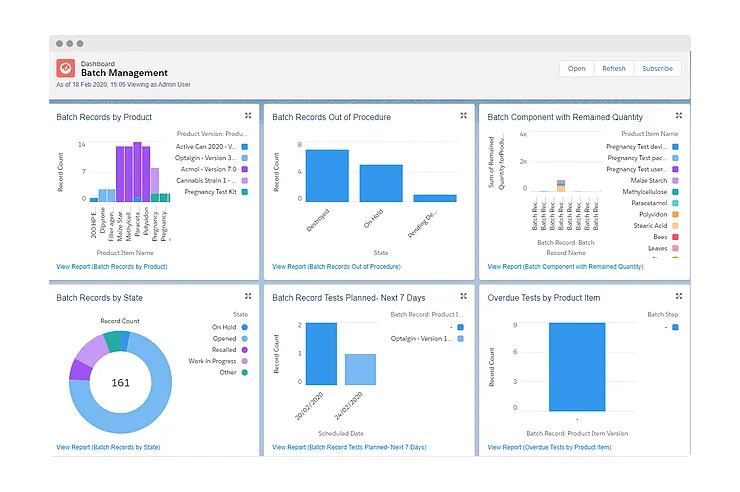When it comes to manufacturing pharmaceuticals quality is critical. Following current Good Manufacturing Practices (cGMP) can help ensure that nothing goes wrong, as these practices lay the foundation for creating quality products. In most countries, cGMP is one of the conditions a company must meet to be allowed to sell its products in one jurisdiction or another.

Because the pharmaceutical industry is unique in its potential impact on public health, it has its own set of regulatory demands it must meet. However, it’s not only about regulation. cGMP standards help pharmaceutical manufacturers establish systems that promote informed design, monitoring, control of processes, materials, and facilities involved in the production of drugs, and that can be applied across the complete and globalized supply chain
Any deviation from the standard operating procedure could result in the release of contaminated medications or worse, which could result in the loss of an entire batch of product, leading to potential drug shortages and lost profit, among other things.
To help make sure this doesn’t happen, following cGMP guidelines in keeping thorough and accurate records and documentation is necessary throughout the manufacturing process. This is where batch records come in. Batch records are one of the most important types of records in the pharmaceutical manufacturing industry, and it’s worth taking the time to perfect yours.
Types of Batch Records in Pharmaceutical Manufacturing
The batch manufacturing record (BMR) is a document containing the instructions that must be followed when manufacturing medication. It includes information like product name, weight and count of each component in the medication, a list of all processes and procedures to follow, and the expected yield of each batch. Essentially, the BMR is the template for producing a drug and so it must be followed with precision and care.
An efficient BMR can help reduce medication shortages caused by production delays or quality control issues, which can account for up to 66% of medicine shortages. They also help prevent contamination or other potential issues that could arise during the process. To ensure that medication is manufactured according to cGMP, a batch production record is used to check the BMR.
What is a Batch Production Record?
Unlike the BMR, which outlines the manufacturing process, the Batch Production Record (BPR) is a complete history of each stage of the pharmaceutical manufacturing process for each lot, or batch, of medication produced. In essence, it’s a kind of checklist to ensure the instructions in the BMR are followed by everyone involved in the manufacturing process. It exists to provide proof that the BMR was addressed, which is key because, as the FDA states in their guidelines, “If it’s not written down, it didn’t happen.”
Why are BMRs so important?
BMRs detail the manufacturing process to ensure it is efficient, successful, and compliant. Those involved in the process have accurate instruction on things like maintenance, product components preparation, and quantities, among other things.
Batch Manufacturing Records enable manufacturers to manage the different production methods required for each kind of product. Dietary supplements and tablets follow a different process and have different requirements from an injectable drug, for example.
Because of these variations in the manufacturing process, it’s important to understand the key components that go into making the perfect BMR.
The Anatomy of a Perfect Batch Manufacturing Record
While the details are different for every product that is produced in a manufacturing facility, the required details of a BMR are the same. This helps ensure that the fundamentals of cGMP are followed with each medication, regardless of the manufacturing process.
Every BMR is required to include:
- Batch record
- Batch number. A numeric record of a production run. Used to identify specific batches.
- Composition. The materials that are required to make the product. This also contains the quantity of each component required per unit.
- Size and weight. The dimension of the finished product.
- Storage conditions. How the components should be stored prior to manufacturing.
- Master formula of the batch. The process of manufacturing the product. This includes composition, weights of components, and specific details like manufacturing equipment settings.
- Start and completion date and expiry date. When batch production started and when it ended, as well as the expiration date of the products in the batch.
- Manufacturer’s license number. The required documentation license.
- Bill of Material
A list of all the raw materials that are used during the manufacturing process, along with quantity and weight.
- Health and safety guidelines
Instructions and guidelines to ensure a safe working environment for employees, including their duties in maintaining it.
- Manufacturing procedure
A detailed outline of each step of the production process. These must be clear and easy-to-follow, so there is no confusion during the batch run.
- Equipment cleaning record
A detailed checklist for cleaning the equipment used during the production run. It lists when everything was cleaned, who cleaned it, and which runs it was used for.
- Yield
Calculations of how much product should be produced at each step of the process. The final product must be no less than 99% of this value.
- Abbreviations
An easy-to-understand list of all the abbreviations used during the batch run.
- History of Changes
A record of all changes made during the process, what the revision number is for the batch, and the date the changes were made.
Along with the following information, it’s important to date and sign the documentation at every step of the process. When possible, timestamps should also be provided. This makes it easier for regulatory bodies or manufacturers to be as precise as possible when tracking down any issues in the process.
Streamlining Batch Records Review with eBMR & What’s Next
Current practices for BMRs involve a lot of paper records (yes, spreadsheets are still considered paper). These, along with being time-consuming to fill out and manage, don’t give manufacturers easy access to invaluable data. Data they can use to streamline processes and reduce costs, while improving the quality of their batch runs.
As the technology to handle and document these processes improves, embracing digital transformation puts manufacturers in a position to out-pace the competition. Moreover, the growing complexities of global supply and manufacturing chains impacting batch record management processes demand a platform to support the operations while maintaining compliance across jurisdictions. To ensure this happens, you need a digital batch record management system that can serve as a single source of truth for processes and decisions within the organization and in business partner relationships.
With the amount of data that can be accessed through a digital and compliance process, manufacturers gain access to a single point of truth for all the data related to the manufacturing process. This, in turn, enables safer and more efficient manufacturing processes regardless of how distributed they are between locations and participating parties.
Rather than spend time digging through paper records to look for relevant information, it can all be found within a single platform that provides an electronic batch manufacturing record, or an eBMR. This digital tool that can filter and present information based on specific criteria. This puts production managers, QA managers and auditors in a position to easily confirm that all the required data has been captured in a timely manner. Not to the point of rushing through the process, but to make it a bit simpler. It puts workers in a position to focus more on the quality of the product being produced. This, in turn, results in a reduction of costs and an increase in output.

When you combine the information collected during the manufacturing process with data from the rest of the company, you unlock the potential that all of that data contains. By analyzing all of this combined data, it becomes possible to find operational efficiencies that can help streamline the manufacturing process, reduce costs, and help eliminate human error.
Having all of this data also makes it possible to further drive innovation through improved manufacturing methods, processes, and tools. The goal is to make it easier to create a better, more efficient system that goes hand in hand with regulatory compliance.
Taking steps towards the future
With the right technology in place and a healthy attitude towards digital transformation, it’s possible for pharmaceutical manufacturers to grow their business. It’s not only about creating a better batch production instructions and documentation processes. It’s about growing the bottom line.
More importantly, it’s about building trust among consumers. One of the roles of standardization and regulatory compliance demands in healthcare industries is nourishing and strengthening this trust. With only 55% of people trusting pharmaceutical companies world wide, accurate documentation is key to trust from both distributors and consumers.
cGMP standards are put in place first and foremost to protect public health from things like human error and bad manufacturing standards. However, compliance can do much more for your business than put a seal of approval on the products you release. By applying a complete solution tailor-made to enable effective batch record management, you can leverage regulatory demands to scale your business. All without worrying about audits or missed non-conformities in the product.
Dot Compliance offers a feature-rich quality assurance and batch record management suite with record-fast deployment speeds and cutting-edge analytics capabilities. Contact us for a demo and discover how our quality management system can help you grow your business and maintain compliance.
(This post was outlines and edited by yours truly and is syndicated here upon the request of the content rights owner. The post was originally published on the DotCompliance blog, the content of which I manage.)
Hi, @techslut!
You just got a 0.04% upvote from SteemPlus!
To get higher upvotes, earn more SteemPlus Points (SPP). On your Steemit wallet, check your SPP balance and click on "How to earn SPP?" to find out all the ways to earn.
If you're not using SteemPlus yet, please check our last posts in here to see the many ways in which SteemPlus can improve your Steem experience on Steemit and Busy.
Hi @techslut!
Your UA account score is currently 5.952 which ranks you at #344 across all Steem accounts.
Your rank has improved 3 places in the last three days (old rank 347).Your post was upvoted by @steem-ua, new Steem dApp, using UserAuthority for algorithmic post curation!
In our last Algorithmic Curation Round, consisting of 97 contributions, your post is ranked at #12.
Evaluation of your UA score:
Feel free to join our @steem-ua Discord server